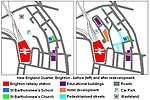Brighton MET College

Brighton MET is a large general further education college located in Brighton and Hove, It is now part of the Chichester College Group after Greater Brighton Metropolitan College merged with CCG on 1 August 2021. It has two campus: Central Brighton Campus, Pelham Street, Brighton and East Brighton Campus, Wilson Avenue, Brighton. It had previously been named City College Brighton & Hove, Brighton College of Technology, Brighton Technical College and Brighton College of Arts and Technology. The college is a popular choice for visual arts progression from nearby colleges e.g. A-level art and photography courses, and provides academic grounding in workmanships such as woodwork, carpentry, engineering, plumbing and electronics. The technical progressions the college provided gave opportunities for post-GCSE students wishing to pursue a specific profession rather than studying multiple A-levels. The college also supported adult learning for over 21s, including those without existing traditional qualifications but the necessary experience and intentions. The college embraces media technologies with the introduction of video games related qualifications. Courses syllabuses were regularly updated with new technologies to keep tuition up to date and the most desirable by employers.
Excerpt from the Wikipedia article Brighton MET College (License: CC BY-SA 3.0, Authors, Images).Brighton MET College
Pelham Street, Brighton Round Hill
Geographical coordinates (GPS) Address Nearby Places Show on map
Geographical coordinates (GPS)
| Latitude | Longitude |
|---|---|
| N 50.8292 ° | E -0.1371 ° |
Address
Brighton MET
Pelham Street
BN1 4FA Brighton, Round Hill
England, United Kingdom
Open on Google Maps











